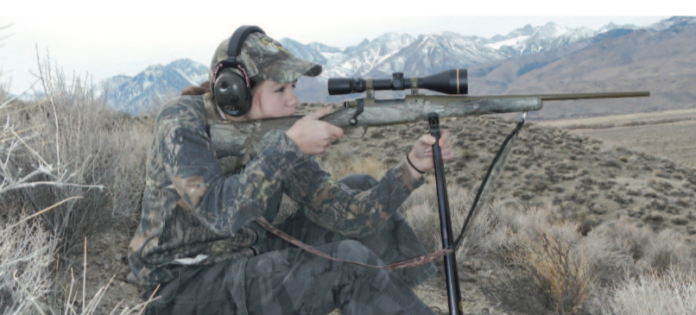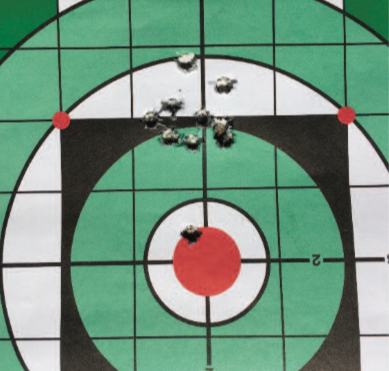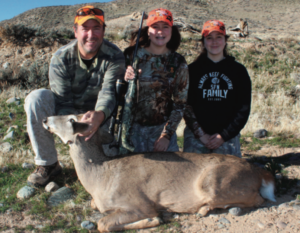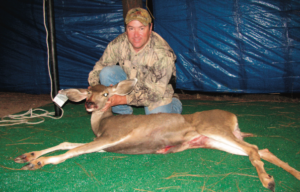
BY TIM E. HOVEY
Back when I first started hunting, sighting in my centerfire scoped rifles usually occurred in the field. I’d find a small rock on a hillside, steady the rifle on my knees and take a couple of shots. If I hit the intended target a few times, I called it good. If I felt the scope sights were off, I’d adjust them a little, take a few more shots until I was satisfied and then go hunting. For hunting small game, it was quick and efficient.
As I accumulated higher caliber rifles and started getting serious about hunting, I started reading up on proper firearm sighting techniques and I started becoming slightly obsessed with accuracy. When it comes to killing cleanly, a good hunter wants to consistently place a bullet exactly where he’s aiming.
One of the popular standards for sighting in your rifle is to adjust your scope settings so that your point of impact is measured approximately an inch high of the bullseye at 100 yards. With favorable conditions, like no wind and aiming as close to horizontal as possible, this technique assumes that the projectile has reached its maximum trajectory at 100 yards. Depending on the caliber, this should give you an additional 100 yards of relative accuracy as the projectile begins to lose velocity and fall back to earth.

For decades, this common sighting practice was how I sighted in most of my center fire rifles regardless of caliber. Whether it was a Ruger .204 or a 30-06, I was adjusting the point of impact to 1-inch high at 100 yards. I developed a mindset that once I was done adjusting my scope settings, I was very confident at hitting my target out to 200 yards.
As you spend more time hunting, especially big game animals, you start to realize that 200 yards of confirmed accuracy really isn’t that far. Frequently, big game animals are spotted from a greater distance. It is then the responsibility of the hunter to close that distance and set up for a shot that he or she is comfortable taking. While getting as close as possible is ideal, often closing the distance to inside 200 yards isn’t possible due to terrain or other factors.
A little over a decade ago, I read an article on a sighting technique called Maximum Point-Blank Range, or MPBR. MPBR is a strategic way to sight in your rifle to match the specific bullet weight and caliber you’re shooting. This allows you to hold your sights on the center of a target and hit it as long as it is within the MPBR of that particular caliber and bullet weight. The idea is that you can adjust how you zero your rifle (scope settings) to eliminate holdover at distant targets.
Here’s an example. Standard ballistic tables show us that without using MPBR, a 30-06 (180 gr.) bullet zeroed at 100 yards will experience the following drops in trajectory: at 200 yards (-4.9 inches) and at 300 yards (-18.3 inches). This means that if you’re attempting to hit a buck out at 300 yards, you’ll have to holdover a foot and a half to hit your target. And at that distance, your holdover is an estimated guess.

Using MPBR and changing the initial point of impact at 100 yards changes things dramatically. Using the same 180-grain bullet, zeroed in for 2.7 inches high at 100 yards (the suggested MBPR adjustment for this caliber and bullet weight), the following bullet trajectories are achieved: at 200 yards the bullet trajectory is plus 1.5 inches and the projectile will have an MPBR of 270 yards. This means that if you used MPBR with this particular caliber and bullet weight, your impact point will be 270 yards. Even if your target is at 300 yards out – 30 yards farther – holding dead on the target will result in hitting the vitals, completely eliminating the guesswork of holdover.
Only a month after I started using MPBR, I got a chance to actually see the results. I was hunting deer on Catalina Island and we had the opportunity to take two doe each. On the last day of the hunt we kicked up a nice doe out of a shallow drainage. The deer hopped out away from us but checked up at 305 yards. I heard our guide state the distance and also mention that it was a long shot. Resting on a fence post, I placed the crosshairs on the vitals just behind the shoulder and squeezed the trigger. The deer fell right there. No holdover, no guesswork, just finding the vitals and making the shot, all thanks to MPBR.
To me, the benefit of using MPBR to sight in your hunting rifle will assist you in eliminating holdover on distant targets. From where you stand out to the maximum point-blank range of your cartridge, you can place the crosshairs on fur and squeeze the trigger with confidence.
If I know I may be taking longer shots, I don’t hesitate to adjust my rifle using MPBR. Knowing the MPBR of your cartridge will give you the confidence to take longer shots effectively but will also enable you to make small holdover adjustments if the distance is a bit further than your cartridge’s MPBR.

In 2016 I took my daughters on a deer hunt to Wyoming. We had access to a ranch that allowed us to fill our tags with does and we were all anxious to get on the hunt. During the first afternoon, I spotted a large doe feeding in an alfalfa field. He was 1,000 yards out and I decided to leave girls in the truck as I closed the distance. I got to a lasered 429 yards and could get no closer. Knowing I was sighted in for the MBPR for my cartridge and I had been dinging the 400-yard steel at the range the week before, I placed the crosshairs on the deer’s back just above his vitals and squeezed the trigger. The deer took three steps and collapsed. To date, that is my longest shot on a big game animal.
Once you’ve dialed in your hunting rifle for the hunt, you need to be consistent with your ammo. To be consistently accurate with your firearm, you also have to hunt with the same ammo brand and bullet weight you used to sight in your hunting rifle. Different bullet weights and different manufactured brands will have a different point of impact out of your rifle, throwing off the MPBR. Stay consistent at the range and on the hunt.
Thinking about how you hunt and the game you’ll be chasing will drive how you sight in your hunting rifle. Most casual hunters are happy to leave the internet trajectory tables behind and adjust their point of impact at one-inch high at 100 yards. Others that know they may encounter longer shots should investigate MPBR. If you’re serious about hunting success, and why wouldn’t you be, extending your shot range without having to mess with excessive holdover is a plus.
Any technique that will make my job easier when it comes time to squeeze that trigger is going to be a well-used tool in my hunting tool bag. After all, using MPBR has resulted in the longest two shots described above of my lengthy hunting career, and that’s good enough for me.



